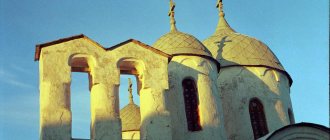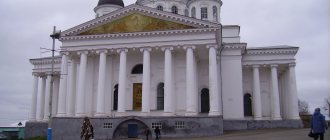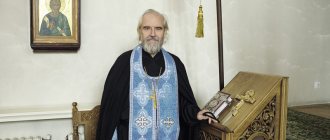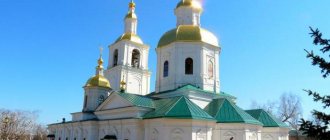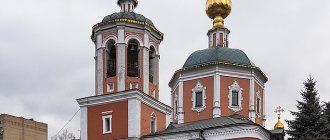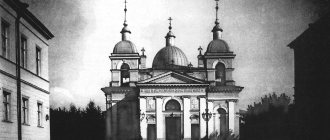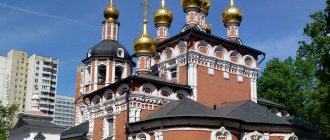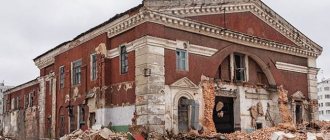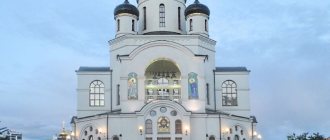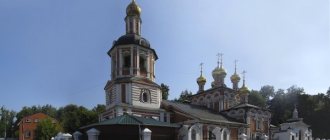The Alexander-Svirsky Monastery is one of the Orthodox spiritual centers operating in the Leningrad region. The men's monastery, regularly visited by pilgrims, travelers and tourist groups, is located in the village of Staraya Sloboda, 21 km from the town of Lodeynoye Pole. The remoteness of large settlements, virgin nature and the picturesque shore of Lake Roshchinskoye create a unique atmosphere of peace and harmony, promoting the awareness of spiritual truths and priorities.
View of the monastery from the shore of Lake Roshchinskoye, © Δημήτριος
Description of the Alexander-Svirsky Monastery
The Orthodox monastery, which includes famous architectural monuments of the 16th-17th centuries, was founded by Alexander Svirsky (1448-1533) at the end of the 15th century in the Olonets region (formerly Korelsky Land). At that time, these places were surrounded by dense forests and pagan settlements. The saint, now revered as a saint, quickly gained disciples and followers from among the indigenous population. The fame of the pious monk, which reached the most remote corners, attracted monks and lay people in need of prayerful help to his place of residence.
Even during the life of the Monk Alexander, two territorially separated complexes were formed in the monastery, connected by a path trodden along the lake:
- Trinity - at the fraternal cells;
- Preobrazhensky - next to the monastery cemetery.
Alexander-Svirsky Monastery in the 18th - early 19th centuries. called "Northern Lavra". He controlled about 30 monasteries and local deserts (remote monastic settlements).
The main part of the monastery's buildings was perfectly preserved, despite periodic raids by enemies and the difficult post-revolutionary period, when the relics of Alexander Svirsky were taken away, the sacristy was looted, ancient icons were destroyed, and the monks were dispersed or shot. In different years of the twentieth century, the territory and unique architectural monuments were used as a forced labor camp for prisoners, a nursing home, a psychiatric hospital and barracks.
The restoration of the Alexander-Svirsky Monastery began in 1997. The new inhabitants have made a lot of efforts, but today the complex is in need of major restoration efforts.
Church of the Intercession of the Blessed Virgin Mary with a refectory, © Masha Malinovskaya
Temples of the monastery
In the Trinity complex there are:
- Church of the Intercession of the Mother of God - built of stone in 1533–36. under Alexander Svirsky at the sacrificial funds of the Sovereign and Grand Duke of All Rus' Vasily III. The oldest (surviving) monastery church has a refectory;
- Trinity Cathedral - a stone structure erected in 1695–97. on the site of the wooden church of the same name, founded in 1508, and the stone church that replaced it in 1526. Inside the cathedral, frescoes created in 1709 have been preserved;
- belfry - a multi-span three-tiered structure with three tents appeared around 1646–48. Previously, the structure was wooden, with five tents;
- Church of St. John of Damascus - was built in 1716–18.
Three-tented belfry, © Lyudmila
On the territory of the Preobrazhensky complex there are:
- Transfiguration Cathedral - a wooden frame was erected in 1533, but during the period of the Polish-Lithuanian devastation (1618) it burned down. The stone structure was erected in 1641, and the chapel in the name of the founder of the monastery was erected in 1716. Later, the cathedral was reconstructed several times;
- Church of St. Zechariah and St. Elizabeth - added to the Transfiguration Cathedral in 1685;
- Gate Church of St. Nicholas the Wonderworker - located in the bishop's chambers above the entrance to the complex. Construction date unknown;
- Chapel of the Life-Giving Trinity - erected in 1791 on the foundation of a wooden church built by the founder of the monastery on the site of the appearance of the Most Holy Trinity to him;
- Chapel of Alexander Svirsky - located outside the Preobrazhensky complex. It was built in 1791 over a well, personally dug by the founder of the monastery and consecrated for the brethren;
- bell tower - erected in 1903-1904.
Gate Church of St. Nicholas the Wonderworker, © Masha Malinovskaya
In addition to the temples, the Alexander-Svirsky Monastery houses buildings - the bishop's, fraternal and cell buildings. Each of the two complexes is surrounded by walls. You can enter through the gate. In the open areas there are wide paths, plaster vases with flowers, lawns, benches, and lamps.
History of the monastery
The wonderful and at the same time difficult history of the holy monastery began more than 500 years ago. The venerable 26-year-old Alexander Svirsky took monastic vows on Valaam. The desire for solitude led him to the bank of the Svir River near Lake Roshchinskoye. However, the disciples of the famous hermit followed him and set up a monastic settlement nearby.
After a prayerful vision of the Holy Trinity, the monk decided to found a church. And nearby the construction of the Church of the Intercession of the Blessed Virgin Mary began, which still exists today. During its heyday, the Northern Lavra was subordinate to dozens of deserts and monasteries. On its territory there were eight churches, a refectory, a book depository and outbuildings. The monastery was a real spiritual stronghold of Orthodoxy with rich iconostases and other valuables. And the relics of Alexander Svirsky, who passed away in 1533, found their place in the Transfiguration Church.
The revolutionary events of 1917 brought the complete looting of churches. The abbot and a number of monks were shot. And the relics of the saint were transferred to the Military Medical Service.
The monastery premises were used as an orphanage, a labor camp, a technical school and a psychiatric hospital. The revival of the ancient center of Orthodoxy began only in 1997. Monks settled on its territory again. And the long-awaited return of the holy relics took place. Every year, during the celebration of Trinity, the remains are transferred in a procession from Transfiguration to the Trinity Cathedral.
Relics of Alexander Svirsky
The main shrine of the monastery is the relics of its founder. Even in the most difficult times, accompanied by enemy invasions, looting and fires, no one dared to touch the incorruptible remains of the saint. However, in 1918, the relics of Alexander Svirsky were seized, opened, examined, taken out and placed in one of the anatomical museums. The exhibit was listed for a long time as “the mummified body of an unknown man.” It took a lot of time to find the incorruptible flesh and examine it, but some historians continue to express doubts about the veracity of the shrine.
The second discovery of the relics of Alexander Svirsky took place on July 30, 1998, which became a major event for the reviving monastery.
Frescoes, © Lyudmila
The Alexander-Svirsky Monastery houses several more shrines, including:
- place of the appearance of the Holy Trinity;
- place of the appearance of the Blessed Virgin Mary;
- a copy of the Shroud of Turin;
- icons and frescoes;
- holy springs of drinking water.
Alexander-Svirsky Monastery - official website
What shrines are kept in the monastery?
Most pilgrims first of all strive to get to the remains of Alexander Svirsky, wanting to touch their beneficial power and strengthen their faith.
The monastery houses one of the few copies of the Shroud of Turin - the fabric in which the body of Jesus Christ was wrapped after the crucifixion. This shrine, together with a piece of the Holy Cross, is located in the Church of Zechariah and Elizabeth. The funeral shroud flows myrrh, attracting thousands of believers and ordinary tourists with this miracle.
A relatively “new” shrine that arrived from the Odessa diocese is an ark containing pieces of the relics of various saints. Among them are the healer Panteleimon, John Chrysostom, and Nicholas the Wonderworker. In addition, there are pieces of the Lord’s manger and the cross on which He was crucified.
Interesting Facts
- During Soviet times, the relics of the saint were kept as an anatomical exhibit of the “unknown”.
- There is a belief about the saint’s relics helping infertile couples, when prayer at the shrine helped women conceive a baby.
- The dome of Trinity Church is decorated with an image of the Lord blessing with a hand with clenched fingers. This is taken as a sign that these lands are in His hand.
Hotels near the Svirsky Monastery
The Staraya Sloboda hotel is located 10 minutes from the complex. Guests can enjoy comfortable rooms with private bathrooms, refrigerators and TVs. On site there is a restaurant, playgrounds, an equestrian club, parking and a sauna. Free Wi-Fi and bicycle rentals are available to everyone.
Hotel near the Alexander-Svirsky Monastery on the map
Located a 5-minute walk from the monastery, the pilgrimage hotel offers shelter and food in the best hospitable traditions. Living here is subject to certain rules and responsibilities.
Patronal holidays
Dates revered in the monastery include:
- September 12 is the day of remembrance of the founder of the monastery, Alexander Svirsky;
- Day of the Holy Trinity;
- Holy Spirit Day;
- August 9 - the memory of Panteleimon the Healer is venerated;
- August 19 - Transfiguration of the Lord;
- September 18 - Saints Zechariah and Elizabeth are remembered;
- October 14 is the day of the Intercession of the Mother of God.
On December 4 (17), the memory of St. John of Damascus is venerated.
Schedule of work and services
The monastery is open daily from 06:00 to 20:00. On Sundays and holidays - from 08:00 to 20:00. The temple in which the relics of St. Alexander Svirsky, you can freely visit from Monday to Saturday from 10:00 to 17:00, and on Sunday from 12:00 to 17:00.
Trinity Cathedral, © Masha Malinovskaya
Anyone can come to church services. Tourists and excursion groups are allowed to view churches and chapels only after the end of services. Additional restrictions may concern issues related to the internal routine of the fraternity.
Schedule of services in the Alexander-Svirsky Monastery
Shrines
The main shrine, of course, is the incorruptible relics of St. Alexander of Svirsky. Believers can venerate them. Some were even lucky enough to observe the process of myrrh streaming. The saint's hands and feet are open to view. And although the relics are more than five hundred years old, they are perfectly preserved.
The incorrupt relics of St. Alexander are located in the Holy Trinity Alexander Svirsky Monastery
The monastery houses a copy of the Shroud of Turin and particles of the relics of other saints. There is also a healing spring here.
Ancient frescoes and mosaics are of historical and religious value.
Visiting rules
Since the monastery belongs to a closed religious organization, when visiting it you must follow certain rules. It is not allowed to come in beach clothes or too revealing clothes, including shorts, breeches and miniskirts. Women are advised to cover their heads with a scarf and avoid trousers (in extreme cases, the lower part of the body can be wrapped in a piece of any fabric). It would be appropriate to turn off mobile phones when entering churches and chapels.
Photographs and videos on the territory, in churches and chapels are allowed only with the blessing of the clergy.
The following is strictly prohibited on the territory of the complex:
- smoke;
- drink alcohol;
- run;
- make noise;
- to swear;
- walk on the lawns;
- sunbathe and swim;
- enter residential premises and outbuildings.
Iconostasis, © Lyudmila
Excursions for groups can only be carried out with the blessing of the abbot of the monastery and accompanied by representatives of the pilgrimage service. The application must be sent in advance. More detailed information is posted on the official website of the Orthodox monastery.
Metochion of the Alexander-Svirsky Monastery
Before the 1917 revolution, the monastery's courtyard was located next to the Yamsky market in St. Petersburg. Today this building houses a tuberculosis dispensary, and for the construction of a new courtyard another place was allocated at the address: lane. Chelieva, 10.
A small Church of the Nativity of Christ was erected on the territory, in which two shrines are kept:
- The Life-Giving Cross of the Lord with particles of important Orthodox relics;
- The Zhirovitsky Icon of the Mother of God is an exact copy given by the Dormition Zhirovitsky Monastery.
Official website of the Svirsky Monastery Metochion
In 2021, Metropolitan Barsanuphius consecrated the main altar of the temple in the village of Vesele
In 2012, it was decided to donate the relics of the Apostle Peter to the temple for eternal possession. In 2021, Metropolitan Barsanuphius consecrated the main altar of the church in the village of Vesele and led the divine liturgy there.
In 2021, Metropolitan Barsanuphius consecrated the main altar of the Church of the Apostle Peter in the village of Vesele, after which he led the Divine Liturgy there
How to get to the Alexander-Svirsky Monastery
The distance from the Northern capital to the village of Staraya Sloboda, where the monastery is located, is about 270 km.
Direct flight from St. Petersburg
From bus station No. 2, located in St. Petersburg on the Obvodny Canal embankment No. 36, bus No. 863 departs daily. Travel time is 5 hours. The schedule can be viewed on the website.
With a transfer from St. Petersburg
Bus No. 963 passes through the Lodeynoye Pole bus station on the route St. Petersburg - Pitkyaranta. After getting off at the stop, you need to transfer to bus No. 89/91, heading towards Pogo and Kandushi, and get to the village of Svirskoye.
You can get to the Alexander-Svirsky Monastery from St. Petersburg by electric train No. 6012/6014, departing from the Ladozhsky railway station. He will deliver to the station. "Lodeynoe field" Then you will need to transfer to bus No. 89/91 or a minibus that runs between the railway station and the monastery complex.
- Schedule of buses departing from the bus station in Lodeynoye Pole.
- Schedule of electric trains running from Ladozhsky station in St. Petersburg to Lodeynoye Pole.
The courtyard of the Alexander-Svirsky Monastery in St. Petersburg can be reached by public transport to the stops “st. Novoselov" or "st. Telman":
- by bus - No. 12, 97, 118;
- by minibuses - No. K-12, K-97, K-365, K-385;
- by trams - No. 7, 27, 39.
Poklonny Cross on the highway at the turn to Staraya Sloboda
By personal vehicle
The fastest and most convenient route will take a little more than three hours. From the ring road of St. Petersburg you need to turn onto the Murmansk highway (also known as the E-105, R-21, Kola highway) and get to the Poklonny Cross. Next, turn left to the village of Svirskoye. From here to Staraya Sloboda - only 6 km.
In addition to the methods described above, you can get to the Alexander-Svirsky Monastery from St. Petersburg as part of excursion pilgrimage groups.
Alexander-Svirsky Monastery: video
